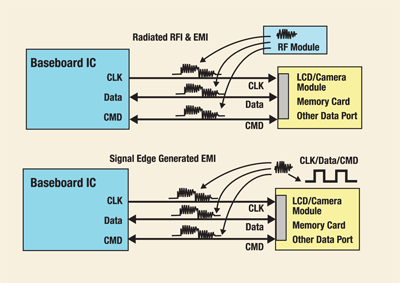New-world designs still need to deal with old-world problems
BY RICHARD RENARD
STMicroelectronics
Lexington, MA
http://www.st.com
Modern materials and technology produce ESD and EMI as ever-present hazards. What we wear and touch create potential for ESD, and digital technology has added to the EMI hazard always present in any electrical device.
ESD can destroy electronic components in mobile phones. The phone can be replaced, but the disruption to the user can be significant. EMI presents itself in audio circuits as hisses, crackles, buzzes, and generally poor sound quality that users will not tolerate. So, EMI disturbances must be filtered out of the audio circuits.
Digital data lines have a similar issue. The extreme proximity of RF block and digital data lines such as the USB and display buses creates vulnerability to interference.
ESD
Mobile phones need protection from ESD and external connections to the circuits are among the most common sources. Simply by changing the battery, you subject your phone to an ESD event.
Like all consumer goods, mobile phones have to be ESD certified according to IEC 61000-4-2, which requires the device to be able to sustain, without damage, a ±15-kV air discharge (through 330 Ω / 150 pF) that corresponds to more than a 45-A strike in 1 ns.

Fig. 1. During an ESD event, an ESD protection device produces a controlled, or clamping voltage.
xtra ESD protection must be implemented at each potential ESD entry point.
EMI
Today digital signals are constantly changing between on and off states creating lots of radiated signals.
Radiated and conducted EMI can be generated at the audio input/output and then transmitted to higher-frequency RF lines, causing signal distortionRadiated and conducted EMI can be generated by the high-speed switching of display and camera data lines and then transmitted to higher-frequency RF lines, causing loss of sensitivityThe RF signal from the phone antenna can be received by the long wires of the headset and induce noise in the audio signal path.
The GSM mobile-phone standard uses frequency- and time-division multiplexing to carry many calls at once. A given mobile phone will emit only during its own time slot. The fundamental frequency of the envelope signal is 1/4.615 ms = 217 Hz. The harmonic frequencies are 434 Hz, 651 Hz, etc., and are audible.
Filters
Putting EMI filters as close as possible to the entry point of the EMI disturbance minimizes the audio-quality degradation. They are required at the display and camera high-speed data bus. The increased signal data rate flowing through a long flexible PCB generates high-frequency harmonics affecting the RF sensitivity of the mobile handset. Long cables act as an antenna, coupling noise to the display driver chip or the processor-display I/O causing signal degradation. The choice of the filter should be driven by its bandwidth, cutoff frequency, and stop-band rejection characteristics.S
Several methods are available for ESD suppression and EMI filtering, including a 24 discrete component design. This solution is not optimized due to the parasitic inductances of the PCB tracks, which cause induce voltages (Li/dt), and antenna-like behavior. It works, but the cost and reliability of mounting 24 components is not optimum.
LTCC EMI filters can be fine-tuned to match filtering requirements. But varistors have high clamping voltages (most likely Vcl > 100 V) and are not best for ESD protection of sensitive submicron ICs.
Integrated passive/active devices (IPADs) combine protection diodes and passive elements such as resistors and high density capacitors on a monolithic silicon chip. The IPAD solution fulfills all the ESD suppression and EMI filter requirements, uses up 78% less PCB space, and offers greater reliability and lower implementation costs. ■
Advertisement
Learn more about STMicroelectronics





